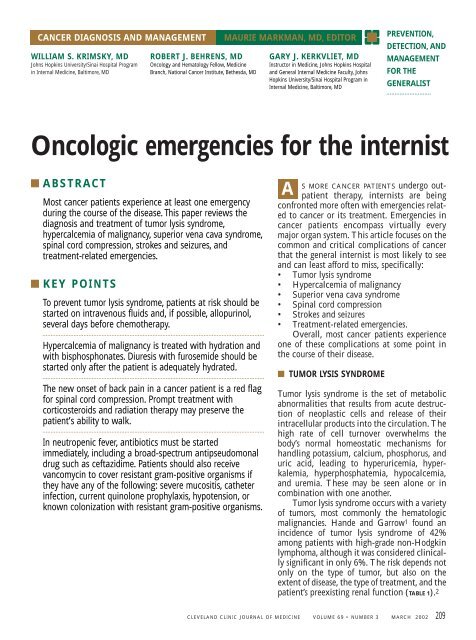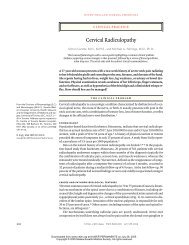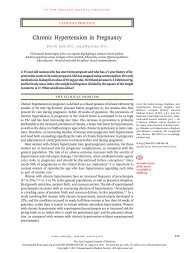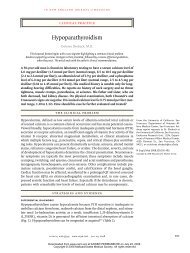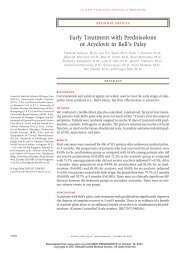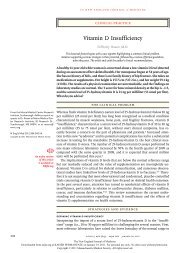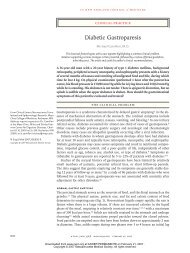Oncologic emergencies for the internist - Cleveland Clinic Journal of ...
Oncologic emergencies for the internist - Cleveland Clinic Journal of ...
Oncologic emergencies for the internist - Cleveland Clinic Journal of ...
You also want an ePaper? Increase the reach of your titles
YUMPU automatically turns print PDFs into web optimized ePapers that Google loves.
CANCER DIAGNOSIS AND MANAGEMENTWILLIAM S. KRIMSKY, MDJohns Hopkins University/Sinai Hospital Programin Internal Medicine, Baltimore, MDROBERT J. BEHRENS, MDOncology and Hematology Fellow, MedicineBranch, National Cancer Institute, Be<strong>the</strong>sda, MDMAURIE MARKMAN, MD, EDITORGARY J. KERKVLIET, MDInstructor in Medicine, Johns Hopkins Hospitaland General Internal Medicine Faculty, JohnsHopkins University/Sinai Hospital Program inInternal Medicine, Baltimore, MDPREVENTION,DETECTION, ANDMANAGEMENTFOR THEGENERALIST<strong>Oncologic</strong> <strong>emergencies</strong> <strong>for</strong> <strong>the</strong> <strong>internist</strong>■ ABSTRACTMost cancer patients experience at least one emergencyduring <strong>the</strong> course <strong>of</strong> <strong>the</strong> disease. This paper reviews <strong>the</strong>diagnosis and treatment <strong>of</strong> tumor lysis syndrome,hypercalcemia <strong>of</strong> malignancy, superior vena cava syndrome,spinal cord compression, strokes and seizures, andtreatment-related <strong>emergencies</strong>.■ KEY POINTSTo prevent tumor lysis syndrome, patients at risk should bestarted on intravenous fluids and, if possible, allopurinol,several days be<strong>for</strong>e chemo<strong>the</strong>rapy.Hypercalcemia <strong>of</strong> malignancy is treated with hydration andwith bisphosphonates. Diuresis with furosemide should bestarted only after <strong>the</strong> patient is adequately hydrated.The new onset <strong>of</strong> back pain in a cancer patient is a red flag<strong>for</strong> spinal cord compression. Prompt treatment withcorticosteroids and radiation <strong>the</strong>rapy may preserve <strong>the</strong>patient’s ability to walk.In neutropenic fever, antibiotics must be startedimmediately, including a broad-spectrum antipseudomonaldrug such as ceftazidime. Patients should also receivevancomycin to cover resistant gram-positive organisms if<strong>the</strong>y have any <strong>of</strong> <strong>the</strong> following: severe mucositis, ca<strong>the</strong>terinfection, current quinolone prophylaxis, hypotension, orknown colonization with resistant gram-positive organisms.AS MORE CANCER PATIENTS undergo outpatient<strong>the</strong>rapy, <strong>internist</strong>s are beingconfronted more <strong>of</strong>ten with <strong>emergencies</strong> relatedto cancer or its treatment. Emergencies incancer patients encompass virtually everymajor organ system. This article focuses on <strong>the</strong>common and critical complications <strong>of</strong> cancerthat <strong>the</strong> general <strong>internist</strong> is most likely to seeand can least af<strong>for</strong>d to miss, specifically:• Tumor lysis syndrome• Hypercalcemia <strong>of</strong> malignancy• Superior vena cava syndrome• Spinal cord compression• Strokes and seizures• Treatment-related <strong>emergencies</strong>.Overall, most cancer patients experienceone <strong>of</strong> <strong>the</strong>se complications at some point in<strong>the</strong> course <strong>of</strong> <strong>the</strong>ir disease.■ TUMOR LYSIS SYNDROMETumor lysis syndrome is <strong>the</strong> set <strong>of</strong> metabolicabnormalities that results from acute destruction<strong>of</strong> neoplastic cells and release <strong>of</strong> <strong>the</strong>irintracellular products into <strong>the</strong> circulation. Thehigh rate <strong>of</strong> cell turnover overwhelms <strong>the</strong>body’s normal homeostatic mechanisms <strong>for</strong>handling potassium, calcium, phosphorus, anduric acid, leading to hyperuricemia, hyperkalemia,hyperphosphatemia, hypocalcemia,and uremia. These may be seen alone or incombination with one ano<strong>the</strong>r.Tumor lysis syndrome occurs with a variety<strong>of</strong> tumors, most commonly <strong>the</strong> hematologicmalignancies. Hande and Garrow 1 found anincidence <strong>of</strong> tumor lysis syndrome <strong>of</strong> 42%among patients with high-grade non-Hodgkinlymphoma, although it was considered clinicallysignificant in only 6%. The risk depends notonly on <strong>the</strong> type <strong>of</strong> tumor, but also on <strong>the</strong>extent <strong>of</strong> disease, <strong>the</strong> type <strong>of</strong> treatment, and <strong>the</strong>patient’s preexisting renal function (TABLE 1). 2CLEVELAND CLINIC JOURNAL OF MEDICINE VOLUME 69 • NUMBER 3 MARCH 2002 209
ONCOLOGIC EMERGENCIESKRIMSKY AND COLLEAGUESHyperkalemia is<strong>the</strong> most lifethreateningproblem intumor lysissyndromeNot available <strong>for</strong>online publication.See print version <strong>of</strong> <strong>the</strong><strong>Cleveland</strong> <strong>Clinic</strong> <strong>Journal</strong><strong>of</strong> MedicineFeatures <strong>of</strong> tumor lysis syndromeHyperuricemia. Catabolism <strong>of</strong> largeamounts <strong>of</strong> both RNA and DNA causes uricacid levels to rise fairly quickly. Normally, uricacid remains in <strong>the</strong> ionized state in <strong>the</strong> body;however, increased levels can lead to urateprecipitation in <strong>the</strong> distal tubule. 3 The result<strong>of</strong> precipitation is an overall decrease in renalfunction.Hyperphosphatemia and hypocalcemiaalso result from <strong>the</strong> above process. Phosphatelevels in neoplastic cells can be as much as fourtimes higher than in normal cells. 4,5 Thebreakdown and release <strong>of</strong> phosphate is initiallycompensated <strong>for</strong> by increased renal excretion.However, as <strong>the</strong> concentration <strong>of</strong> phosphateincreases, it combines with calcium and precipitatesin <strong>the</strong> renal tubule as well as in <strong>the</strong>s<strong>of</strong>t tissues. Consequently, hypocalcemia andrenal failure develop. 6 <strong>Clinic</strong>ally, hypocalcemiacan manifest as agitation, tetany, andbone pain.Hyperkalemia is perhaps <strong>the</strong> most lifethreateningderangement in tumor lysis syndrome.The sudden increase in potassiumresults in <strong>the</strong> well-defined clinical presentation<strong>of</strong> cardiac arrhythmias and death.All <strong>the</strong> above metabolic derangements aremade worse by preexisting renal insufficiency.Treatment <strong>of</strong> tumor lysis syndromeProphylaxis is <strong>the</strong> first step in treatment (TABLE2). 7 If a patient is found to be at high risk <strong>for</strong>tumor lysis syndrome, he or she shouldpromptly be started on both intravenous fluidand allopurinol if <strong>the</strong>re is no contraindicationto it. Close observation during <strong>the</strong>rapy is alsoessential, as transient, urgent hemodialysismay reverse <strong>the</strong> toxicity.■ HYPERCALCEMIA OF MALIGNANCYHypercalcemia <strong>of</strong> malignancy occurs inapproximately 10% to 20% <strong>of</strong> cancerpatients, 8,9 most <strong>of</strong>ten with lung cancer,breast cancer, and <strong>the</strong> hematologic malignanciessuch as multiple myeloma and lymphoma.10Features <strong>of</strong> hypercalcemia <strong>of</strong> malignancySymptoms vary depending on <strong>the</strong> degree <strong>of</strong>hypercalcemia and how quickly it develops.Acute symptoms include nausea, vomiting,constipation, polyuria, polydipsia, muscleweakness, acute renal insufficiency, and mentalstatus changes. Chronic symptoms includekidney stones, bone pain, and depression.Mechanisms <strong>of</strong> hypercalcemia<strong>of</strong> malignancyNormally, calcium levels are maintained by<strong>the</strong> interaction <strong>of</strong> parathyroid hormone, calcitonin,and 1,25(OH) 2 -vitamin D. The disorders<strong>of</strong> calcium metabolism in malignancyusually represent an alteration in one <strong>of</strong> <strong>the</strong>sepathways or extensive lytic bone lesions.Parathyroid hormone-related peptide.The most common cause <strong>of</strong> hypercalcemia <strong>of</strong>malignancy, classically seen in squamous celllung cancer, is a syndrome mediated by production<strong>of</strong> a parathyroid hormone-related peptide(PTHrP). Structurally similar to PTH at<strong>the</strong> amino acid terminus, PTHrP binds toparathyroid hormone receptors, mobilizes calciumfrom bones, and increases renal reabsorption<strong>of</strong> calcium. Evidence suggests that<strong>the</strong>re might be some clinical utility to measuringPTHrP because significant elevations <strong>of</strong>PTHrP seem to correlate with poorer outcomes.11–13Abnormal production <strong>of</strong> calcitriol (1,25-vitamin D). The deregulated conversion <strong>of</strong>210 CLEVELAND CLINIC JOURNAL OF MEDICINE VOLUME 69 • NUMBER 3 MARCH 2002
Not available <strong>for</strong> online publication.See print version <strong>of</strong> <strong>the</strong><strong>Cleveland</strong> <strong>Clinic</strong> <strong>Journal</strong> <strong>of</strong> Medicine25-vitamin D to 1,25-vitamin D appears to beresponsible <strong>for</strong> some <strong>of</strong> <strong>the</strong> hypercalcemia <strong>of</strong>malignancy seen in both Hodgkin lymphomaand non-Hodgkin lymphoma. 14,15 Thus, it issimilar to <strong>the</strong> hypercalcemia associated withsarcoidosis and o<strong>the</strong>r granulomatous diseases.Direct tumor invasion into bony structures.Individual tumor cells secrete a variety<strong>of</strong> mediators, including interleukin-1, interleukin-6,and tumor necrosis factor, that upregulatelocal osteoclastic activity, causingcalcium to be released into <strong>the</strong> serum. 16Treatment <strong>of</strong> hypercalcemia <strong>of</strong> malignancyTreatment must address <strong>the</strong>se various mechanismsto be effective; ideally, <strong>the</strong> best way is byreducing or eliminating <strong>the</strong> causative malignancy.Hydration. Patients with hypercalcemia<strong>of</strong> malignancy invariably present with somedehydration caused by calcium’s effect on <strong>the</strong>kidney. Thus, appropriate managementshould begin with giving intravenous fluids toimprove symptoms and to induce excretion <strong>of</strong>calcium. However, even with adequatehydration, most patients do not achieve anacceptable calcium level, and thus additional<strong>the</strong>rapies are used to control <strong>the</strong> renal andskeletal mechanisms <strong>of</strong> hypercalcemia <strong>of</strong>malignancy.Diuresis with furosemide increases renalexcretion <strong>of</strong> calcium, but should be startedonly when <strong>the</strong> patient has been adequatelyhydrated—o<strong>the</strong>rwise it will exacerbate <strong>the</strong>free water loss relative to <strong>the</strong> loss <strong>of</strong> sodiumand calcium.Bisphosphonates. Most experts recommendusing bisphosphonates, most <strong>of</strong>tenpamidronate, to produce a sustained decreasein <strong>the</strong> calcium level by inhibiting osteoclasticactivity and calcium resorption from bone. 17Pamidronate is given intravenously in ei<strong>the</strong>r aHypercalcemicpatientsinvariably aredehydratedCLEVELAND CLINIC JOURNAL OF MEDICINE VOLUME 69 • NUMBER 3 MARCH 2002 213
ONCOLOGIC EMERGENCIESKRIMSKY AND COLLEAGUESExpertsrecommendpursuing atissue diagnosisin superior venacava syndrome60-mg or a 90-mg dose over at least 2 hours. 18Approximately 60% <strong>of</strong> patients respond to a60-mg dose and nearly 100% to a 90-mgdose. 19 Pamidronate usually takes approximately12 to 48 hours to produce an initialresponse, and <strong>the</strong> response is sustained <strong>for</strong> anaverage <strong>of</strong> about 2 weeks. 20Calcitonin is frequently used in additionto bisphosphonates because it has a rapidonset <strong>of</strong> effect: within 2 to 4 hours <strong>of</strong> administration.21 Its main drawbacks are hypersensitivityreactions and tachyphylaxis; <strong>the</strong> latterusually develops within 3 days.Gallium nitrate and plicamycin are usedinfrequently because <strong>of</strong> <strong>the</strong>ir toxicity.Steroids are frequently helpful in <strong>the</strong>short term, especially in sensitive tumors suchas lymphoma and myeloma.Dialysis remains an option <strong>for</strong> those whocannot tolerate a saline load.■ SUPERIOR VENA CAVA SYNDROMESuperior vena cava syndrome is relatively rare,affecting 2.4% to 4.2% <strong>of</strong> lung cancerpatients, who account <strong>for</strong> 65% <strong>of</strong> all cases. 22Small cell lung cancer is <strong>the</strong> most frequentcause <strong>of</strong> <strong>the</strong> syndrome because it has apredilection <strong>for</strong> <strong>the</strong> central region <strong>of</strong> <strong>the</strong>lungs. 23 Lymphoma accounts <strong>for</strong> 8% <strong>of</strong> cases,and breast cancer and o<strong>the</strong>r mediastinalmetastatic lesions account <strong>for</strong> 10%. 22Of note: several nonmalignant diseasessuch as granulomatous and fibrosing mediastinitis,goiters, and aortic aneurysms can alsocause superior vena cava syndrome.Features <strong>of</strong> superior vena cava syndromeSuperior vena cava syndrome results from anincrease in central venous pressure caused byvena caval obstruction. Typically this producescough, dyspnea, and dysphagia combinedwith swelling and discoloration <strong>of</strong> <strong>the</strong>neck, face, or upper extremities. Dependingon <strong>the</strong> site <strong>of</strong> <strong>the</strong> disease, both vocal cordparalysis and Horner syndrome (sinking in <strong>of</strong><strong>the</strong> eyeball, ptosis <strong>of</strong> <strong>the</strong> upper eyelid, elevation<strong>of</strong> <strong>the</strong> lower lid, constriction <strong>of</strong> <strong>the</strong> pupil,narrowing <strong>of</strong> <strong>the</strong> palpebral fissure, andanhidrosis and flushing <strong>of</strong> <strong>the</strong> affected side <strong>of</strong><strong>the</strong> face; caused by compression <strong>of</strong> sympa<strong>the</strong>ticnerves) can occur.Treatment <strong>of</strong> superior vena cava syndromeInitial treatment consists <strong>of</strong> elevating <strong>the</strong>head <strong>of</strong> <strong>the</strong> bed and giving diuretics and corticosteroids.However, corticosteroids are moreuseful when <strong>the</strong> cause <strong>of</strong> <strong>the</strong> obstruction islymphoma ra<strong>the</strong>r than lung cancer.Chemo<strong>the</strong>rapy and radiation <strong>the</strong>rapy.Unless tracheal obstruction is present orimpending, superior vena cava syndrome isnot immediately life-threatening, and mostexperts recommend pursuing a tissue diagnosisso that specific treatment can be given <strong>for</strong> <strong>the</strong>primary tumor alongside treatment <strong>for</strong> <strong>the</strong>symptoms. 22Both primary chemo<strong>the</strong>rapy and radiationare important components <strong>of</strong> <strong>the</strong>rapy. In smallcell lung cancer, Chan et al 24 found no differencein <strong>the</strong> response rate in patients whoreceived chemo<strong>the</strong>rapy compared with radiation<strong>the</strong>rapy. The recurrence rate <strong>of</strong> superiorvena cava syndrome depends on <strong>the</strong> type <strong>of</strong>tumor causing <strong>the</strong> obstruction. In large celllymphoma <strong>the</strong> high risk <strong>of</strong> recurrence withchemo<strong>the</strong>rapy resulted in a recommendationto use radiation <strong>the</strong>rapy. 25Intravenous stenting can relieve symptoms,particularly dyspnea, <strong>for</strong> most patients.Anticoagulation. Thrombus <strong>for</strong>mationoccurs in up to 50% <strong>of</strong> patients with superiorvena cava syndrome. In a small study,Adelstein et al 26 attempted prophylaxis withfull doses <strong>of</strong> heparin and warfarin but found itconferred no survival advantage when treatedpatients were compared with 10 historicalcontrols. However, anticoagulation is stillused <strong>for</strong> symptom relief regardless <strong>of</strong> effect onsurvival.■ SPINAL CORD COMPRESSIONSpinal cord compression is not immediatelylife-threatening unless it involves level C3 orabove, but it may lead to pr<strong>of</strong>ound, permanentmorbidity. Paraplegia or loss <strong>of</strong> sphincter controlor both not only diminishes a patient’squality <strong>of</strong> life but also predisposes to fur<strong>the</strong>rcomplications such as venous thrombosis,decubitus ulcers, and urinary obstruction.Spinal cord compression occurs at sometime in approximately 5% <strong>of</strong> all cancerpatients, 27 most <strong>of</strong>ten in carcinomas <strong>of</strong> <strong>the</strong>prostate, lung, and breast.214 CLEVELAND CLINIC JOURNAL OF MEDICINE VOLUME 69 • NUMBER 3 MARCH 2002
ONCOLOGIC EMERGENCIESKRIMSKY AND COLLEAGUESMRI withoutcontrast is <strong>the</strong>best test <strong>for</strong>spinal cordcompressionFeatures <strong>of</strong> spinal cord compressionPain is <strong>the</strong> primary symptom and iseventually reported in 96% <strong>of</strong> patients withspinal cord compression. 28 The pain may beacute or may gradually increase over weeks.Although <strong>the</strong> pain is similar to that <strong>of</strong> discdisease, one potential difference is that <strong>the</strong>pain <strong>of</strong> spinal cord compression can beincreased in <strong>the</strong> supine position anddecreased when upright.O<strong>the</strong>r signs and symptoms are weakness,sensory deficits, and autonomic dysfunction.Diagnosis <strong>of</strong> spinal cord compressionIt is <strong>of</strong>ten difficult to decide whe<strong>the</strong>r a patientwith back pain should be thoroughly evaluatedto exclude spinal cord compression, but apatient with known or suspected metastaticdisease (especially tumor types with a tropism<strong>for</strong> bone) presenting with a new pain patternor a neurologic deficit deserves meticulousevaluation.Magnetic resonance imaging (MRI)without contrast is <strong>the</strong> best and most costeffectivetest. 29Several nonmalignant conditions, suchas osteoporotic compression fractures andspinal abscesses, may also cause spinal cordcompression and must be diagnosed accurately,as <strong>the</strong>ir treatment and prognosis aremarkedly different.Treatment <strong>of</strong> spinal cord compressionNeurologic compromise can be rapid; <strong>the</strong>re<strong>for</strong>e,treatment must begin quickly after diagnosis.Corticosteroids are a critical part <strong>of</strong> <strong>the</strong>initial management because <strong>the</strong>y decreaseedema that may compress vasculature or <strong>the</strong>nerves directly and lead to permanent injury.Although dosages are debated, <strong>the</strong> minimumis dexamethasone 10 mg (or an equivalent) byintravenous bolus followed by 4 mg intravenouslyevery 6 hours.Radiation <strong>the</strong>rapy. Carcinomas <strong>of</strong> <strong>the</strong>prostate, lung, and breast are more predictablyresponsive to radio<strong>the</strong>rapy than are o<strong>the</strong>rtypes <strong>of</strong> tumors. However, a patient presentingwith any type <strong>of</strong> malignant spinal cord compressionshould also seen urgently by a radiationoncologist.Chemo<strong>the</strong>rapy may be an option <strong>for</strong>extremely chemosensitive tumors such aspediatric neuroblastomas.Surgery is <strong>the</strong> remaining option if a tissuediagnosis is needed, <strong>the</strong> area has previouslyreceived maximal irradiation, spinal stabilizationis needed, or o<strong>the</strong>r treatments are notworking.■ STROKES AND SEIZURESStrokes and seizures are common in cancerpatients. Strokes occur in 7% <strong>of</strong> all cancerpatients 30 and are equally split between hemorrhagicand thrombotic subtypes. Seizuresoccur in 2.7% <strong>of</strong> patients with cerebral metastasesand in 1.8% <strong>of</strong> cancer patients withoutbrain metastases. 31Initial treatment <strong>of</strong> strokes and seizures incancer patients is <strong>the</strong> same as in patients withoutcancer. After initial stabilization, specifictreatment <strong>of</strong> <strong>the</strong> tumor such as radio<strong>the</strong>rapyor steroids should be started. In addition,patients with thrombotic strokes might beconsidered candidates <strong>for</strong> antiplatelet, anticoagulation,or thrombolytic <strong>the</strong>rapy.Patients with cerebral metastasis withouta history <strong>of</strong> seizure should be advised not todrive or engage in activities in which an unexpectedseizure could harm <strong>the</strong>m or o<strong>the</strong>rs.Randomized studies have shown no benefitfrom prophylactic anticonvulsants, 32 withpossible exceptions <strong>for</strong> melanoma brainmetastases or leptomeningeal metastases.■ TREATMENT-RELATED EMERGENCIESExtravasation <strong>of</strong> chemo<strong>the</strong>rapeutic drugsExtravasation—leakage <strong>of</strong> chemo<strong>the</strong>rapeuticdrugs into <strong>the</strong> skin— results in pain, redness,swelling, and even necrosis. Its reported incidenceranges from 0.1% to 6.5% <strong>of</strong>chemo<strong>the</strong>rapy infusions. 33 Although <strong>the</strong>sereactions are usually seen in an oncologic setting,<strong>the</strong>y are increasingly being seen in <strong>the</strong>primary care physician’s <strong>of</strong>fice as morepatients undergo home infusion <strong>the</strong>rapy.Occasionally, symptoms may develophours or days after <strong>the</strong> initial insult. The delaycan be caused by endocytolysis, in which asmall amount <strong>of</strong> drug kills and lyses cells at<strong>the</strong> injection site and <strong>the</strong>n moves on repeat-216 CLEVELAND CLINIC JOURNAL OF MEDICINE VOLUME 69 • NUMBER 3 MARCH 2002
Not available <strong>for</strong> online publication.See print version <strong>of</strong> <strong>the</strong><strong>Cleveland</strong> <strong>Clinic</strong> <strong>Journal</strong> <strong>of</strong> Medicineedly to damage <strong>the</strong> surrounding tissues.Extravasation is important because largeareas <strong>of</strong> skin may break down, leading to poorcosmetic results, secondary infection, andcontractures if <strong>the</strong> injury is over a joint.The most common culprits are vesicants,which cause blisters when <strong>the</strong>y contact skin.Anthracyclines (eg, doxorubicin and idarubicin)and vinca alkaloids (eg, vincristine andvinorelbine) are <strong>the</strong> most common vesicantsused in clinical practice.If <strong>the</strong> patient is complaining <strong>of</strong> pain orproblems during vesicant infusion, <strong>the</strong> infusionshould be stopped, <strong>the</strong> line aspirated toremove residual drug, and an antidote (ifavailable) instilled through <strong>the</strong> line (TABLE 3). 33If using a port, disconnect <strong>the</strong> infusion line; ifusing a temporary intravenous line, discontinueit. Compression <strong>of</strong> <strong>the</strong> site should be avoidedas this may spread <strong>the</strong> remaining drug fur<strong>the</strong>rout from <strong>the</strong> injection site. The use <strong>of</strong>heat, ice, and antidotes depends on <strong>the</strong> specificchemo<strong>the</strong>rapeutic drug.If a patient presents to an <strong>internist</strong> withpain at an injection site, with or without redness,shortly after a chemo<strong>the</strong>rapy infusion, heor she should be referred to his or her treatingoncologist urgently.Neutropenic feverNeutropenic fever is common, and if it is leftuntreated <strong>the</strong> mortality rate is 50%. 34Neutropenia is defined as a neutrophilcount lower than 0.5 ×10 9 /L (500/mm 3 ), orless than 1.0 × 10 9 /L and expected to declinebelow 0.5 soon. A fever is defined as a singletemperature <strong>of</strong> 38.3˚C (101.0˚F) or higher, ora temperature <strong>of</strong> 38.0˚C (100.4˚F) or higherlasting over 1 hour.A complete fever workup should be completed,and <strong>the</strong>n antibiotics should be startedpromptly. All patients should receive a broadspectrumantipseudomonal drug such as ceftazidime.They also should receive vancomycinto cover resistant gram-positiveorganisms if any <strong>of</strong> <strong>the</strong> following is present:severe mucositis, ca<strong>the</strong>ter infection, currentquinolone prophylaxis, hypotension, orknown colonization with resistant gram-positiveorganisms. Often, despite a comprehensivesearch, <strong>the</strong> cause is never found; however,it is essential to start antibiotics immediatelyupon noting a neutropenic fever. Antibioticsshould be continued until <strong>the</strong> absolute neutrophilcount exceeds 0.5 × 10 9 /L and <strong>the</strong>patient is afebrile.It is important <strong>for</strong> <strong>the</strong> patient and all <strong>of</strong>his or her contacts to routinely wash <strong>the</strong>irhands.DehydrationOften overlooked, dehydration is a serious riskand is very common in cancer patients because<strong>of</strong> cachexia caused by <strong>the</strong> disease or its treat-Stop <strong>the</strong>infusion if <strong>the</strong>patientcomplains <strong>of</strong>pain duringvesicantinfusionCLEVELAND CLINIC JOURNAL OF MEDICINE VOLUME 69 • NUMBER 3 MARCH 2002 217
ONCOLOGIC EMERGENCIESKRIMSKY AND COLLEAGUESment. Dehydration is associated with deliriumin 30% <strong>of</strong> cancer patients and is linked toshorter survival. 35 Common treatment-relatedcauses include emesis, diarrhea, and mucositis.For example, in some series <strong>of</strong> colon cancerpatients, 36 approximately 50% required achange in treatment because <strong>of</strong> dehydrationand 20% required intravenous fluids.An <strong>internist</strong> can improve a patient’s quality<strong>of</strong> life by providing supportive care withfluids, antiemetics, and antidiarrheal drugsand by communicating with <strong>the</strong> oncologist todiscuss adverse effects that may require achange in treatment.■ REFERENCES1. Hande KR, Garrow GC. Acute tumor lysis syndrome inpatients with high grade non-Hodgkin’s lymphoma. Am JMed 1993; 94:133–139.2. Flombaum CD. Metabolic <strong>emergencies</strong> in <strong>the</strong> cancerpatient. Semin Oncol 2000; 27:322–334.3. Conger JD, Falk SA. Intrarenal dynamics in <strong>the</strong> pathogenesisand presentation <strong>of</strong> acute urate nephropathy. J ClinInvest 1977; 59:786–793.4. Zusman J, Brown DM, Nesbit ME. Hyperphosphatemia,hyperphosphaturia, and hypocalcemia in acute lymphoblasticleukemia. N Engl J Med 1973; 289:1335–1340.5. Rigas DA, Duerst ML, Jump ME, Osgood EE. The nucleicacids and o<strong>the</strong>r phosphorous compounds <strong>of</strong> humanleukemic leukocytes: relation to cell maturity. J Lab ClinMed 1956; 8:356–378.6. Ettinger DS, Harker WG, Gerry HW, Sanders RC, Saral R.Hyperphosphatemia, hypocalcemia, and transient renalfailure: results <strong>of</strong> cytotoxic treatment <strong>of</strong> acute lymphoblasticleukemia. JAMA 1978; 239:2472–2474.7. Flombaum C. Electrolyte and renal abnormalities. In:Groeger JS, editor: Critical Care <strong>of</strong> <strong>the</strong> Cancer Patient,2nd ed. St Louis, Mosby Year Book, 1991:140–164.8. Mundy GR, Guise TA. Hypercalcemia <strong>of</strong> malignancy. Am JMed 1997; 103:134–145.9. Morton AR, Lipton A. Hypercalcemia. In: Abel<strong>of</strong>f MD,Armitage JO, Lichter AS, Niederhuber JE, editors. <strong>Clinic</strong>alOncology. New York: Churchill Livingstone,2000:719–733.Anaphylaxis and capillary leakSome systemic treatments such as interleukin-2 (IL-2) may cause severe hypotension, especiallywhen given at high doses intravenously.The mechanism is decreased systemic vascularresistance and leakage out <strong>of</strong> vessels, leading tointravascular volume depletion. Somehypotension is seen in up to 70% <strong>of</strong> patientsreceiving IL-2 in high doses, and 3% experiencelife-threatening degrees <strong>of</strong> hypotension. 37Close monitoring in an intensive care unit iswise be<strong>for</strong>e starting such high-dose <strong>the</strong>rapy.The treatment is to not give more IL-2until <strong>the</strong> patient recovers and to provide supportivecare with intravenous fluids andphenylephrine. IL-2 in low doses rarely causessuch hypotension.Hemorrhagic cystitisSome chemo<strong>the</strong>rapeutic drugs have toxicmetabolites that are excreted by <strong>the</strong> kidneyand can cause severe bladder hemorrhage. Acommon example is acrolein, which is <strong>for</strong>medby <strong>the</strong> metabolism <strong>of</strong> cyclophosphamide andifosfamide.Hemorrhagic cystitis is more commonwhen urinary output is low, because low urineoutput increases <strong>the</strong> concentration <strong>of</strong> acroleinin <strong>the</strong> urine and <strong>the</strong> duration that <strong>the</strong> bladdermucosa is exposed to it. There<strong>for</strong>e, hydrating<strong>the</strong> patient be<strong>for</strong>e chemo<strong>the</strong>rapy is an importantpreventive measure. Ano<strong>the</strong>r preventivemeasure is to give mesna during chemo<strong>the</strong>rapyinfusion. 38If hemorrhage is severe, exsanguinationmay result. Blood transfusions and a urologyconsult are essential. Continuous bladderinfusions via a three-way ca<strong>the</strong>ter are commonlyused to prevent bladder clots andalso to flush out any remaining uro<strong>the</strong>lialtoxins. Measures as drastic as <strong>for</strong>maldehydebladder infusions or cystectomy are rarelyneeded.10. Warrell RP. Metabolic <strong>emergencies</strong>. In: DeVita VT, HellmanS, Rosenberg SA, editors. Cancer: Principles and Practice<strong>of</strong> Oncology. Philadelphia: Lippincott Williams & Wilkins,2001:2633.11. Gurney H, Grill V, Martin TJ. Parathyroid hormone-relatedprotein and response to pamidronate on tumor inducedhypercalcemia. Lancet 1993; 341:1611–1613.12. Pecherstorfer M, Schilling T, Blind E, et al. Parathyroidhormone-related protein and life expectancy in hypercalcemiccancer patients. J Clin Endocrinol Metab 1994;78:1268–1270.13. Wimalawansa SJ. Significance <strong>of</strong> plasma PTH-rP inpatients with hypercalcemia <strong>of</strong> malignancy treated withbisphosphonate. Cancer 1994; 73:2223–2230.14. Adams JS, Fernandez M, Gacad MA, et al. Vitamin Dmetabolite-mediated hypercalcemia and hypercalciuriapatients with AIDS- and non-AIDS-associated lymphoma.Blood 1989; 73:235–239.15. Breslau NA, McGuire JL, Zerwekh JE, Frenkel EP, Pak CY.Hypercalcemia associated with increased serum calcitriollevels in three patients with lymphoma. Ann Intern Med1984; 100:1–6.16. Klein B, Bataille R. Cytokine network in human multiplemyeloma. Hematol Oncol Clin North Am 1992;6(2):273–284.17. Mundy GR, Guise TA. Hypercalcemia <strong>of</strong> malignancy. Am JMed 1997; 103:134–145.18. Dodwell DJ, Howell A, Morton AR, Daley-Yates PT,Hoggarth CR. Infusion rate and pharmacokinetics <strong>of</strong>Dehydration iscommon and<strong>of</strong>tenoverlooked incancer patientsCLEVELAND CLINIC JOURNAL OF MEDICINE VOLUME 69 • NUMBER 3 MARCH 2002 221
KRIMSKY AND COLLEAGUESVisitOurWebsiteFor In<strong>for</strong>mationonOnline CME&Upcoming Courses• Great Lakes Thrombosis Update, April 20, 2002• Contrast Echocardiographyand New Technologies, May 8, 2002• Update in Headache Management, May 15, 2002intravenous pamidronate in <strong>the</strong> treatment <strong>of</strong> tumorinducedhypercalcemia. Postgrad Med J 1992; 68:434–439.19. Nussbaum SR, Younger J, Vandepol CJ. Single-dose intravenous<strong>the</strong>rapy with pamidronate <strong>for</strong> <strong>the</strong> treatment <strong>of</strong>hypercalcemia <strong>of</strong> malignancy: Comparison <strong>of</strong> 30-, 60-, and90-mg dosages. Am J Med 1993; 95:297–304.20. Wimalawansa SJ. Optimal frequency <strong>of</strong> administration <strong>of</strong>pamidronate in patients with hypercalcemia <strong>of</strong> malignancy.Clin Endocrinol 1994; 41:591–595.21. Warrell RP Jr, Israel R, Frisone M, Snyder T, Gaynor JJ,Bockman RS. Gallium nitrate <strong>for</strong> acute treatment <strong>of</strong> cancer-relatedhypercalcemia. A randomized double-blindcomparison to calcitonin. Ann Intern Med 1988;108:669–674.22. Yahalom J. Superior vena cava syndrome. In: DeVita VT,Hellman S, Rosenberg SA, editors. Cancer: Principles andPractice <strong>of</strong> Oncology. Philadelphia: Lippincott Williams &Wilkins, 2001:2609–2653.23. Sculier JP, Evans WK, Feld R, et al. Superior vena cavaobstruction in small cell lung cancer. Cancer 1986;57:847–851.24. Chan RH, Dar AR, Yu E, et al. Superior vena cava obstructionin small cell lung cancer. Int J Radiat Oncol Biol Phys1997; 38:513–520.25. Perez-Soler R, McLaughlin P, Velasquez WS, et al. <strong>Clinic</strong>alfeatures and results <strong>of</strong> management <strong>of</strong> superior vena cavasyndrome secondary to lymphoma. J Clin Oncol 1984;2:260–266.26. Adelstein DL, Hines JD, Carter SG, et al. Thromboembolicevents on patients with malignant superior vena cava syndromeand <strong>the</strong> role <strong>of</strong> cardiac function. Cancer 1988;62:2258–2262.27. Byrne TN. Spinal cord compression from epidural metastases.N Engl J Med 1992; 327:614–619.28. Gilbert RW, Kim J-H, Posner JB. Epidural spinal cord compressionfrom metastatic tumor: diagnosis and treatment.Ann Neurol 1978; 3:40–51.29. Fuller BG, Heiss JD, Oldfield EH. Spinal cord compression.In: DeVita VT, Hellman S, Rosenberg SA, editors. Cancer:Principles and Practice <strong>of</strong> Oncology. Philadelphia:Lippincott Williams & Wilkins, 2001:2623–2624.30. Schiff D, Batchelor T, Wen PY. Neurologic <strong>emergencies</strong> incancer patients. Neurol Clin 1998; 16:449–483.31. Clouston PD, DeAngelis LM, Posner JB. The spectrum <strong>of</strong>neurological disease in patients with systemic cancer. AnnNeurol 1992; 31:268–273.32. Schiff D, Batchelor T, Wen PY. Neurologic <strong>emergencies</strong> incancer patients. Neurol Clin 1998; 16:449–483.33. Albanell J, Baselga J. Systemic <strong>the</strong>rapy <strong>emergencies</strong>. SeminOncol 2000; 27:347–361.34. Hughes WT, Armstrong D, Bodey GP, et al. 1997Guidelines <strong>for</strong> <strong>the</strong> use <strong>of</strong> antimicrobial agents in neutropenicpatients with unexplained fever. Clin Infect Dis1997; 25:551–573.35. Lawlor PG, Gagnon B, Mancini IL, et al. Occurrence, causes,and outcome <strong>of</strong> delirium in patients with advancedcancer. Arch Intern Med 2000; 160:786–794.36. Arbuckle RB, Huber SL, Zacker C. The consequences <strong>of</strong>diarrhea occurring during chemo<strong>the</strong>rapy <strong>for</strong> colorectalcancer: a retrospective study. Oncologist 2000; 5:250–259.37. Physician’s Desk Reference in Micromedex; 1998.Druginfo.cc.nih.gov.38. Hensley ML, Schuchter LM, Lindley C, et al. AmericanSociety <strong>of</strong> <strong>Clinic</strong>al Oncology clinical practice guidelines <strong>for</strong><strong>the</strong> use <strong>of</strong> chemo<strong>the</strong>rapy and radio<strong>the</strong>rapy protectants. JClin Oncol 1999; 17:3333–3355.ADDRESS: Robert J. Behrens, MD, National Cancer Institute,Navy Building 8, Room 5101, Be<strong>the</strong>sda, MD 20892; e-mailbehrensr@mail.nih.gov.222 CLEVELAND CLINIC JOURNAL OF MEDICINE VOLUME 69 • NUMBER 3 MARCH 2002


